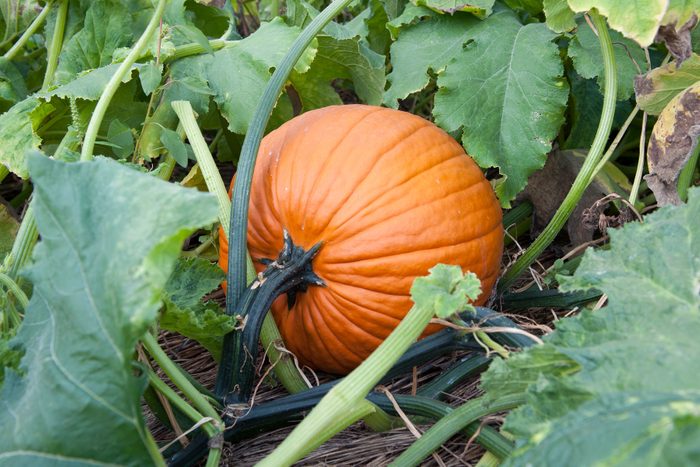Grow a Jack-O-Lantern: Tips for Growing Pumpkins for Halloween
Updated: Jun. 05, 2024

It's amazing to see how fast and far a pumpkin vine can grow in one season, producing several pumpkins that make perfect jack-o'-lanterns.
Growing pumpkins for jack-o’-lanterns and Halloween decorations is big business in some states, including Indiana (where I live) and neighboring Illinois, the national leader. Across the United States, we grow around one billion pounds of pumpkins each year. Nearly 80 percent are sold for fall and Halloween decorations.
On This Page
Best Pumpkin Varieties for Halloween
Looking to grow your own pumpkins specifically to carve for Halloween? Some good choices include:
- Jack O Lantern: An heirloom variety that produces medium-sized pumpkins.
- Lumina: White with orange flesh.
- Triple Treat: Good for carving and eating, with mature pumpkins weighing about eight pounds.
When To Plant Pumpkins for Halloween
Most pumpkins grown for Halloween take around 100 days to mature. They don’t tolerate frost, especially as young seedlings.
With this in mind, if your garden is frost free by early May, sow seeds directly in the garden then and you should have pumpkins to harvest by early fall. Sow three to four seeds together, then thin them out to two seedlings to continue growing.
In more Northern areas, including U.S. Department of Agriculture Plant Hardiness Zones 5 and colder, start pumpkin seeds indoors in a biodegradable pot two to three weeks before your predicted frost-free date, with no more than two seeds per pot. Once your garden is frost free, harden off the seedlings. Then plant them in the garden, being careful not to disturb the roots.
How To Grow Pumpkins
Location
Choose a sunny spot with well-drained soil with lots of room for the vines to grow. To improve drainage, mound up the soil six to eight inches and plant the seeds in the center of the mound. Depending on the variety, pumpkin vines can be six to 10 feet long and will sprawl out in all directions.
Watering
Pumpkins grow fast and need a lot of water, at least one to two inches per week. If you’re not getting enough rain, water with a trickle near the base of the plants — that’s the best way. This allows water to slowly seep into the soil without wetting the foliage.
A drip irrigation system is great for pumpkins. If you water with an overhead sprinkler, do it early in the day to give foliage a chance to dry off by midday.
Fertilizing
If you’re unsure of your soil fertility or your pumpkins aren’t growing well, apply a general purpose liquid fertilizer, following instructions on the label. Remove any weeds that compete for soil nutrients. Vines are fragile, so be careful not to step on them when weeding.
Harvesting
Pumpkins are ready to harvest once the skins are hard and brightly colored.
Cut the pumpkin away from the vine, leaving at least three inches of the stem on the pumpkin. Wipe off any dirt and allow it to dry in the sun for a week or so to further harden the skin. Then store in a cool, dry place until you’re ready to carve it for Halloween.
To prevent mold from forming on the pumpkin, wipe it down with a diluted bleach solution, using one part bleach to nine parts water.
Pests and diseases
A long list of pests and diseases could attack your growing pumpkins, but don’t let that discourage you. Some tips to avoid pests and diseases include:
- Never plant pumpkins in the same location two years in a row, or plant where other squashes were grown the previous year.
- Water early in the morning and avoid wetting the foliage too much.
- Place straw under maturing pumpkins to keep them off the bare ground, which can cause them to rot.
- Watch for squash bugs and pick them off if found.
Why Doesn’t My Pumpkin Vine Produce Any Pumpkins?
Pumpkins produce male and female flowers on the same plant. Male flowers will open first, followed by female flowers a few weeks later.
If there are no bees around to pollinate the female flowers, pumpkins won’t form. If this is the case, pick a male flower on the end of a long, thin stem. Then rub the pollen from it onto a female flower, which will have a swollen base.
It’s also possible if your plant is under stress from too little or too much water or other problems, the female flowers just won’t produce pumpkins.
Can I Save Seeds From My Pumpkins To Grow Next Year?
Yes. If you didn’t grow any other varieties of pumpkins, gourds or other squashes in your garden, you can save the seeds from your pumpkin and expect to grow the same variety the next year. Remove the seeds from the pulp, rinse until clean, lay out on a towel to dry, then store in a cool, dry location.
